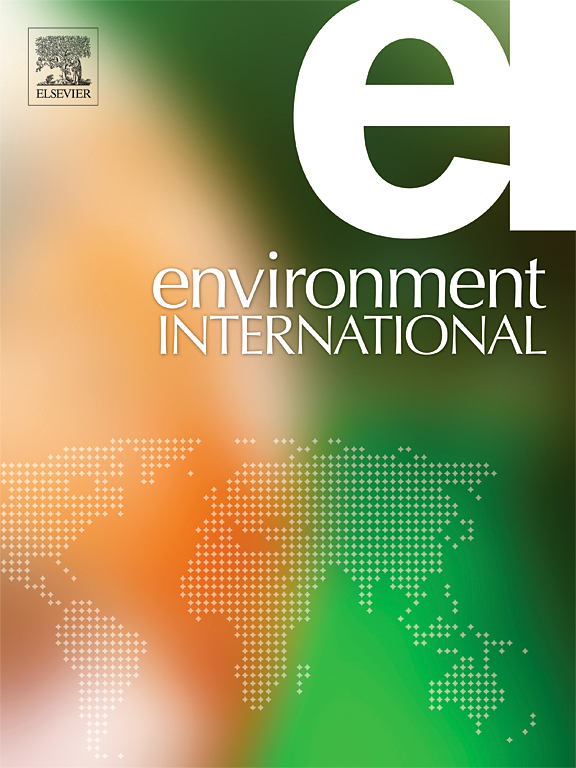高温对巴西住院率影响的区域差异
IF 9.7
1区 环境科学与生态学
Q1 ENVIRONMENTAL SCIENCES
引用次数: 0
摘要
气候变化导致的高温严重威胁着全球健康。它们对卫生系统的影响,特别是对低收入和中等收入国家卫生系统的影响,仍未得到充分探讨。方法从巴西医院信息系统中收集2008-2019年巴西5459个(98%)城市的每日非选择性住院情况。从欧洲中期天气预报再分析中心V5获得了历史时期(2008-2023)的格网日最高气温,并在三种SSP排放情景下预测到2060年。人口预测来自世界人口普查。我们使用病例时间序列设计和分布滞后非线性模型来检验每个州的温度与住院风险之间的关系,估计2008年至2060年因热而住院的人数。使用疾病成本法估算相关经济成本,包括直接和间接成本。如果没有适应,预计2050年 在SSP1-2.6、SSP2-4.5和SSP5-8.5情景下,与高温相关的年住院率将分别达到每10万人51人(95 % CI: 19-103)、54人(21-106)和59人(25-112),比2010年 每10万人33人(9-67)的基线增加54 %、62 %和78 %。到2050年 年代,年度经济成本预计将达到2.28亿至2.64亿美元,其中南方的绝对成本更高,北方的相对增长更快。高温对住院的重大影响及其对卫生部门和更广泛经济的相关成本,在未来的气候和人口变化下会恶化。区域适应和有针对性的卫生保健投资对于管理日益增加的卫生负担至关重要。资助英国研究和创新;中国留学基金委。本文章由计算机程序翻译,如有差异,请以英文原文为准。
Regional variations in the impacts of high temperature on hospital admissions in Brazil
Background
High temperatures driven by climate change significantly threaten global health. Their impact on health systems, particularly within low- and middle-income countries, remains underexplored.
Methods
Daily non-elective hospital admissions were collected from the Brazil Hospital Information System for 5,459 (98%) Brazilian municipalities, 2008–2019. Gridded daily maximum temperatures were obtained from the European Centre for Medium-Range Weather Forecasts Reanalysis V5 for the historical period (2008–2023) and projected up to 2060 under three SSP emission scenarios. Population projections were derived from WorldPop. We used a case time-series design and distributed lag non-linear models to examine the relationship between temperature and hospitalisation risk for each state, estimating the number of heat-attributable hospitalisations from 2008 to 2060. Related economic costs were estimated using a cost-of-illness approach including direct and indirect costs.
Findings
Without adaptation, high-temperature-related annual hospitalisations were projected to reach 51 (95 % CI: 19–103), 54 (21–106), and 59 (25–112) per 100,000 population in the 2050s under SSP1-2.6, SSP2-4.5, and SSP5-8.5 scenarios, respectively, representing 54 %, 62 %, and 78 % increases from the 2010s baseline of 33 (9–67) per 100,000. Annual economic costs were projected to reach $228–$264 million in the 2050s, with higher absolute costs in the South and faster relative increases in the North.
Interpretation
The substantial impact of heat on hospitalisations, and its associated costs to the health sector and wider economy, worsen under future climate and demographic change. Regional adaptation and targeted healthcare investments are crucial to manage rising health burdens.
Funding
UK Research and Innovation; China Scholarship Council.
求助全文
通过发布文献求助,成功后即可免费获取论文全文。
去求助
来源期刊

Environment International
环境科学-环境科学
CiteScore
21.90
自引率
3.40%
发文量
734
审稿时长
2.8 months
期刊介绍:
Environmental Health publishes manuscripts focusing on critical aspects of environmental and occupational medicine, including studies in toxicology and epidemiology, to illuminate the human health implications of exposure to environmental hazards. The journal adopts an open-access model and practices open peer review.
It caters to scientists and practitioners across all environmental science domains, directly or indirectly impacting human health and well-being. With a commitment to enhancing the prevention of environmentally-related health risks, Environmental Health serves as a public health journal for the community and scientists engaged in matters of public health significance concerning the environment.
 求助内容:
求助内容: 应助结果提醒方式:
应助结果提醒方式:


